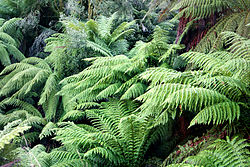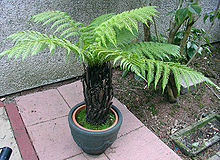- Cyatheales
-
Tree fern (Cyatheales) 
Dicksonia antarctica Scientific classification Kingdom: Plantae Division: Pteridophyta Class: Polypodiopsida/Pteridopsida (disputed)
Subclass: Cyatheatae Order: Cyatheales Families and Genera - Thyrsopteridaceae
- Loxsomataceae
- Loxsoma
- Loxsomopsis
- Culcitaceae
- Plagiogyriaceae
- Cibotiaceae
- Cyatheaceae
- Dicksoniaceae
- Calochlaena
- Dicksonia
- Lophosoria
- Metaxyaceae
- Metaxya
The order Cyatheales is a taxonomic division of the fern subclass, Cyatheatae, which includes the tree ferns. No clear morphological features characterize all of the Cyatheales, but DNA sequence data indicates that the order is monophyletic. Some species in the Cyatheales have tree-like growth forms, but others have creeping rhizomes (stems). Some species have scales on the stems and leaves, while others have hairs. However, most plants in the Cyatheales are tree ferns and have trunk-like stems up to 20 meters tall. It is unclear how many times the tree form has evolved and been lost in the order.[1]
Contents
Description
In general, any fern that grows with a trunk elevating the fronds (leaves) above ground level can be called a tree fern. However, the plants formally known as tree ferns comprise a group of large ferns belonging to the families Dicksoniaceae and Cyatheaceae in the order Cyatheales.
Tree ferns are found growing in tropical and subtropical areas as well as temperate rainforests in Australia, New Zealand, and other island groups nearby; a few genera extend further, such as Culcita in southern Europe. Like all ferns, tree ferns reproduce by means of spores developed in sporangia on the undersides of the fronds.
The fronds of tree ferns are usually very large and multiple-pinnate but at least one type has entire (undivided) fronds. The fronds of tree ferns also exhibit circinate vernation, meaning the young fronds emerge in coils that uncurl as they grow.
Unlike flowering plants, tree ferns do not form new woody tissue in their trunk as they grow. Rather, the trunk is supported by a fibrous mass of roots that expands as the tree fern grows.
Some tree fern genera — for example Dicksonia and Cibotium, but not Cyathea — can be transplanted by severing the top portion from the rest of the trunk and replanting it. If the transplanted top part is kept moist it will regrow a new root system over the next year. The success rate of transplantation increases to about 80% if the roots are dug up intact. If the crown of the Tasmanian tree fern Dicksonia antarctica (the most common species in gardens) is damaged, it will die because that is where all new growth occurs. But other clump-forming tree fern species, such as D. squarrosa and D. youngiae, can regenerate from basal offsets or from "pups" emerging along the surviving trunk length. Tree ferns often fall over in the wild, yet manage to re-root from this new prostrate position and begin new vertical growth.
 Tree fern frond ("fiddlehead") by the Akatarawa River, New Zealand. These unopened fronds are edible but must be roasted first to remove shikimic acid.
Tree fern frond ("fiddlehead") by the Akatarawa River, New Zealand. These unopened fronds are edible but must be roasted first to remove shikimic acid.
It is not certain how many species of tree fern there are but it is likely to be around a thousand. Although new species are discovered in New Guinea with each botanical survey, many species throughout its range have become extinct in the last century as forest habitats have come under pressure from human intervention.
Threats to tree ferns
While many ferns are able to achieve a widespread distribution because of their spore reproduction, tree fern species tend to be very local. This makes their species much more susceptible to the effects of local deforestation. It is not known why species are not more widespread, especially considering that they have sufficient height to have a greater chance of getting spore into the wind stream.[citation needed]
Where feral pigs are a problem, such as in some Hawaiian rainforests, they will knock over tree ferns to root out the starchy pith, killing the plant.[2]
Non-Cyatheales tree ferns
Outside of the Cyatheales a few ferns in other groups could be considered tree ferns, such as several ferns in the family Osmundaceae that can achieve short trunks under 1 metre (3.3 ft) tall. A few species in the genera Blechnum, Leptopteris, Sadleria and Todea could also be considered tree ferns in a liberal interpretation of the term.
The families that constitute Cyatheales have been relatively firmly established as a clade by DNA sequencing and morphological studies. The order Plagiogyriales, which contains the family Plagiogyriaceae, is most closely related to the Cyatheales, not to the Osmundales as had been previously supposed.
 Transplanted Dicksonia antarctica tree ferns at Combe Martin Wildlife and Dinosaur Park, Devon, England.
Transplanted Dicksonia antarctica tree ferns at Combe Martin Wildlife and Dinosaur Park, Devon, England.
References
- ^ Judd, W.S., C.S. Campbell, E.A. Kellogg, P.F. Stevens, and M.J. Donoghue (Eds.) 2008. Plant Systematics: A Phylogenetic Approach, Third Edition. Sinauer Associates, Sunderland, Massachusetts, USA.
- ^ Baskin, Yvonne (2003). A Plague of Rats and Rubbervines: The Growing Threat of Species Invasions. Island Press. pp. 74–75. ISBN 9781559630511.
- Pryer, K.M., A.R. Smith, and J.E. Skog. 1995. Phylogenetic relationships of extant ferns based on evidence from morphology and rbcL sequences. American Fern Journal 85: 205-282.
- C.Michael Hogan. 2010. Fern. Encyclopedia of Earth. National council for Science and the Environment. Washington, DC
- Large, M.F. and J.E. Braggins Tree Ferns. Timber Press (2004).
- Smith, A.R., K.M. Pryer, E. Schuettpelz, P. Korall, H. Schneider & P.G. Wolf 2006. A classification for extant ferns.PDF (420 KiB) Taxonomy 55(3): 705-731.
External links
- Community: Care and propagation of Treeferns (German/English)
- Fern Files: Tree Ferns
Categories:
Wikimedia Foundation. 2010.

